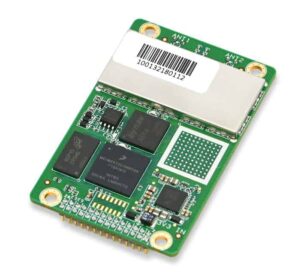 Bynav has released two new GNSS receivers designed for high-volume markets such as autonomous vehicles, V2X (vehicle-to-everything) and robotics. The C1 GNSS RTK OEM receiver and the A1 industrial-grade IMU (inertial measurement unit)-enhanced GNSS OEM receiver are both based on Bynav’s GNSS baseband Alita ASIC and Ripley RFIC chipsets.
Bynav has released two new GNSS receivers designed for high-volume markets such as autonomous vehicles, V2X (vehicle-to-everything) and robotics. The C1 GNSS RTK OEM receiver and the A1 industrial-grade IMU (inertial measurement unit)-enhanced GNSS OEM receiver are both based on Bynav’s GNSS baseband Alita ASIC and Ripley RFIC chipsets.
The C1 GNSS RTK OEM receiver board measures 46×71mm and supports dual-antenna heading and all GNSS constellations (GPS, BDS, Galileo, GLONASS, QZSS, NavIC and SBAS) with an RTK position accuracy of 1cm+1ppm RMS. It provides a wide range of I/O interfaces including UART serial port, Ethernet, 3 EVENT_IN, 3 EVENT_OUT, 1PPS and CANbus, for easy integration with external IMUs, odometry, LiDAR or visual SLAM.
The A1 GNSS/INS OEM receiver, measuring 46×71mm and weighing 25g, is integrated with an industrial-grade IMU (gyro 2.7deg/hr) with an embedded deeply coupled GNSS+INS algorithm engine and tilt measurement algorithms. It provides stable, high precision position and attitude even in GNSS-denied environments.
Bynav is a strategic partner of Duolun Technology, China’s leading vehicle driver testing system integrator, and its GNSS RTK receivers have already been integrated into thousands of vehicles. The performance of the A1 and C1 have been verified by many domestic customers in the vehicle driver testing and autonomous driving industries.
Ying Long, deputy general manager of CIDI (Changsha Intelligent Driving Institute), a well-known autonomous driving company in China, commented: “We are committed to developing intelligent driving vehicles and commercializing them as soon as possible. The GNSS/INS receiver plays an important role to provide absolute position. That’s why I started work together with Bynav for a cost-effective and high-performance positioning solution. Currently the Bynav’s GNSS/INS receivers have been used in our unmanned sweepers, self-driving trucks and other products, and it comes out that the A1 performance is comparable to the world-class and high-end products we used.”


















